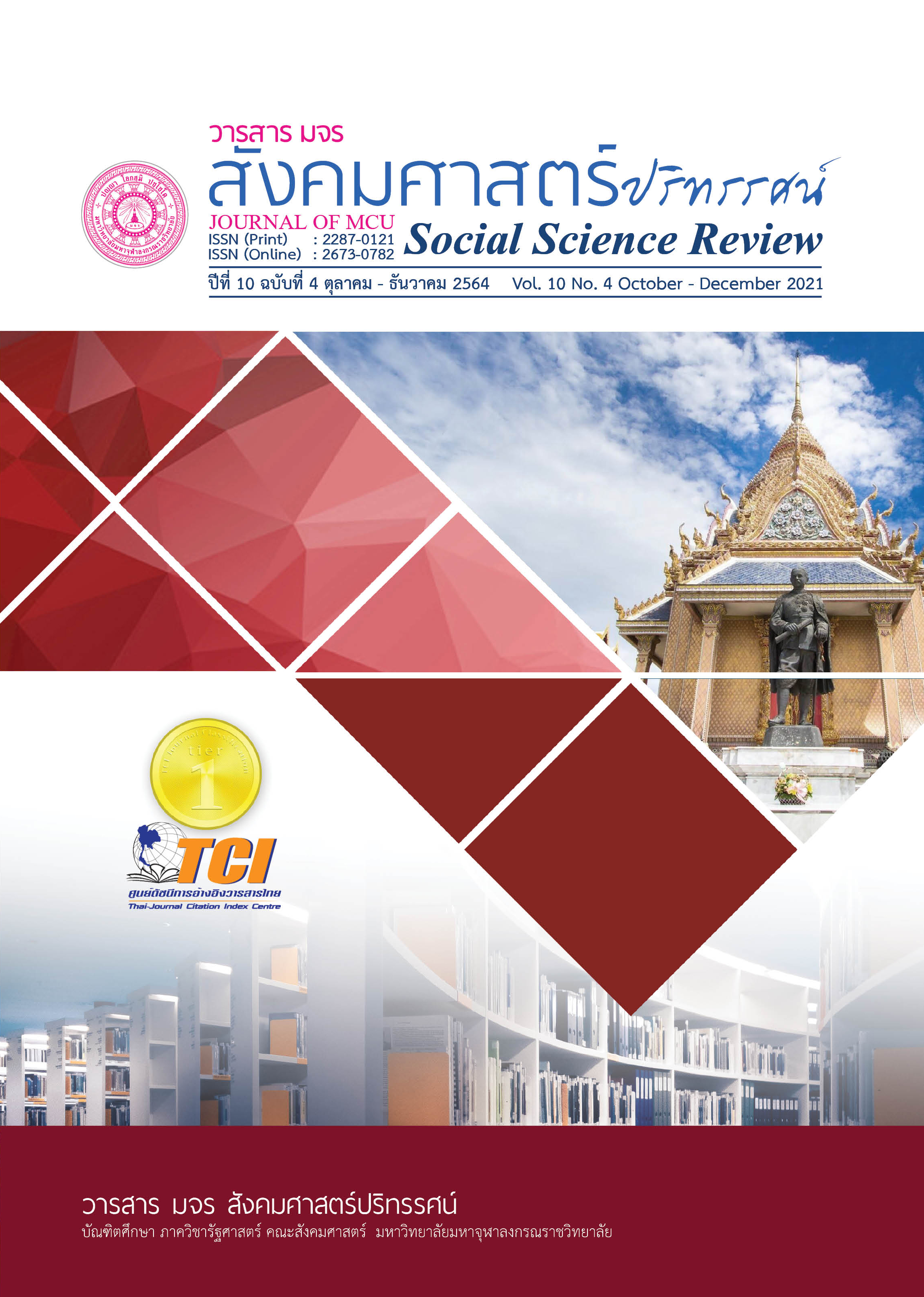การพัฒนาทรัพยากรมนุษย์โดยหลักพุทธธรรมที่จิตตกอง บังคลาเทศ
คำสำคัญ:
การพัฒนาทรัพยากรมนุษย์, หลักพุทธธรรม, จิตตกอง บังคลาเทศบทคัดย่อ
วัตถุประสงค์สามข้อของงานวิจัยนี้คือ 1) เพื่อศึกษาการพัฒนาทรัพยากรมนุษย์โดยหลักพุทธธรรม 2) เพื่อศึกษาปัจจัยที่มีผลกระทบการพัฒนาทรัพยากรมนุษย์โดยหลักพุทธธรรม และ 3) นำเสนอแนวทางรูปแบบหลักพุทธธรรมที่เหมาะสมการพัฒนาทรัพยากรมนุษย์โดยหลักพุทธธรรม งานวิจัยนี้อาศัยการวิจัยแบบผสานวิธีทั้งเชิงคุณภาพและเชิงปริมาณ ในเชิงคุณภาพประกอบด้วยการสัมภาษณ์เชิงลึกกับผู้ให้ข้อมูลสำคัญรวม 17 รูปหรือคน และการนำเสนอต่อผู้เข้าร่วมประชุมที่เชี่ยวชาญ สนทนากลุ่มอีก 7 รูปหรือคน ส่วนในเชิงปริมาณมีการเก็บตัวอย่างการสำรวจจากผู้ให้ความคิดเห็นรวม 122 คน เป็นสถิติสำหรับการวิเคราะห์ข้อมูลเชิงปริมาณได้รวบรวมจากแบบสอบถามเชิงสำรวจ ซึ่งมีความเชื่อมั่น 0.949 การวิเคราะห์ข้อมูลใช้โปรแกรมวิเคราะห์ข้อมูลทางสังคมศาสตร์ คำนวณหาค่าความถี่ ค่าร้อยละ ค่าเฉลี่ย และค่าเบี่ยงเบนมาตรฐาน ส่วนการสนทนากลุ่ม 7 รูปหรือคน ทำโดยการนำเสนอต่อการประชุมร่วมกัน ข้อมูลทั้งหมดสำหรับเชิงคุณภาพได้ถูกนำมาประมวลและวิเคราะห์แบบอุปนัยทั้งสัมภาษณ์ในเชิงลึกและการสนทนากลุ่ม
ผลการวิจัยพบว่า 1) การพัฒนาทรัพยากรมนุษย์โดยหลักพุทธธรรม มุ่งเน้นใช้หลักไตรสิกขา: ระดับการรักษาศีล (พฤติกรรม) การเจริญสมาธิและการเจริญปัญญา อยู่ในช่วงเห็นด้วยเกือบทั้งหมด 2) ปัจจัยที่ส่งผลกระทบต่อการพัฒนาทรัพยากรมนุษย์: ปัจจัยที่ส่งผลกระทบภายนอก อยู่ในช่วงความเห็นกลางๆ และปัจจัยส่งผลกระทบภายใน อยู่ในช่วงเห็นด้วยเป็นส่วนใหญ่ 3) แนวทางรูปแบบพุทธธรรมที่เหมาะสมในการพัฒนาทรัพยากรมนุษย์เป็นองค์ความรู้ที่ได้มาจากการวิจัยนี้ โดยสรุปไว้เป็นรูปแบบ หลักพุทธธรรมในการพัฒนาทรัพยากรมนุษย์ โดยใช้ไตรสิกขา มุ่งเน้นในเรื่อง ศีล สมาธิ และปัญญา ทฤษฎี Leonard Nadler ผสมผสานกับอิทธิบาท 4 เกี่ยวกับ การศึกษา การอบรม และการพัฒนา และปัจจัยการสนับสนุนในการพัฒนาทรัพยากรมนุษย์ที่จิตตกอง บังคลาเทศ เกี่ยวกับบทบาทของการมีส่วนร่วมกิจกรรมของชุมชนต่าง ๆ
เอกสารอ้างอิง
Bodhi, Bhikkhu. (1984). The Noble Eightfold Path: The Way to the End of Suffering. Kandy: Buddhist Society.
Buswell & Robert E. (2004). Encyclopedia of Buddhism. USA.
Koontz, H. D.&Cyrill O. (1972). Principle of Management: Analysis of Managerial Functions. New York: McGraw – Hill.
Nadler, L. (1982). Designing Training Program: The critical events model. USA: Mass. Addison – Wesley.
Mahachulalongkornrajavidyalaya University. (2017). Common Buddhist Text Guidance and Insight from The Buddha. Bangkok: MCU.
Payutto, P.A. (2005). A CONSTITUTION FOR LIVING. Bangkok: Sahadhammika.
Phra Buddhaghosa. (2010). Translated from the Pali by Bhikkhu Nanamoli, Visuddhimagga, The Path of Purification. Columbo: Samayawardana.
Siam Pāli Tapiṭaka. (1917). Bangkok: Mahachulalongkornrajavidyalaya.
Srirahula, W. (1988). What the Buddha Taught. Bangkok: Haw Trai Foundation Bangkok.
ดาวน์โหลด
เผยแพร่แล้ว
รูปแบบการอ้างอิง
ฉบับ
ประเภทบทความ
สัญญาอนุญาต
ลิขสิทธิ์ (c) 2021 วารสาร มจร สังคมศาสตร์ปริทรรศน์

อนุญาตภายใต้เงื่อนไข Creative Commons Attribution-NonCommercial-NoDerivatives 4.0 International License.
เพื่อให้เป็นไปตามกฎหมายลิขสิทธิ์ ผู้นิพนธ์ทุกท่านต้องลงลายมือชื่อในแบบฟอร์มใบมอบลิขสิทธิ์บทความให้แก่วารสารฯ พร้อมกับบทความต้นฉบับที่ได้แก้ไขครั้งสุดท้าย นอกจากนี้ ผู้นิพนธ์ทุกท่านต้องยืนยันว่าบทความต้นฉบับที่ส่งมาตีพิมพ์นั้น ได้ส่งมาตีพิมพ์เฉพาะในวารสาร มจร สังคมศาสตร์ปริทรรศน์ เพียงแห่งเดียวเท่านั้น หากมีการใช้ภาพหรือตารางหรือเนื้อหาอื่นๆ ของผู้นิพนธ์อื่นที่ปรากฏในสิ่งตีพิมพ์อื่นมาแล้ว ผู้นิพนธ์ต้องขออนุญาตเจ้าของลิขสิทธิ์ก่อน พร้อมทั้งแสดงหนังสือที่ได้รับการยินยอมต่อบรรณาธิการ ก่อนที่บทความจะได้รับการตีพิมพ์ หากไม่เป็นไปตามข้อกำหนดเบื้องต้น ทางวารสารจะถอดบทความของท่านออกโดยไม่มีข้อยกเว้นใดๆ ทั้งสิ้น





